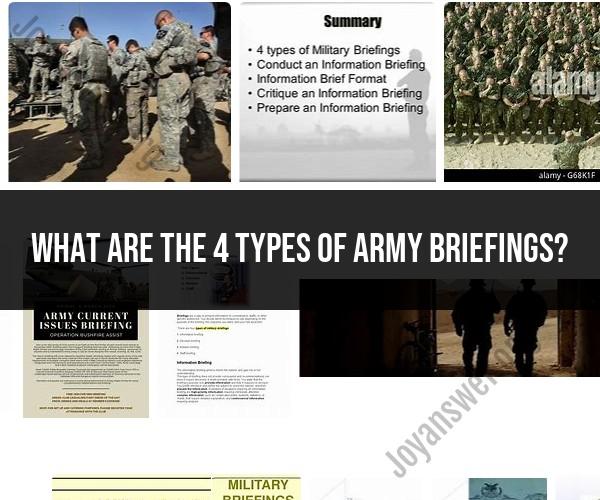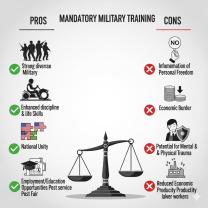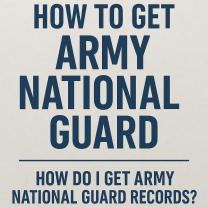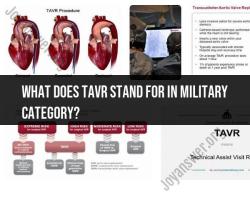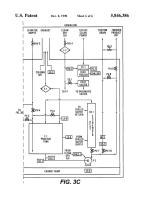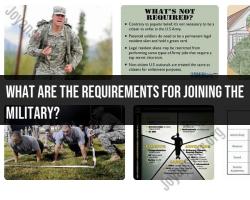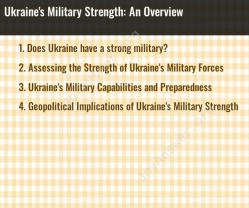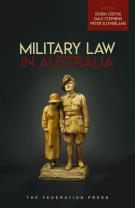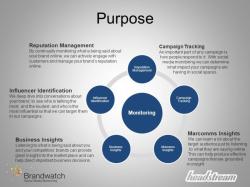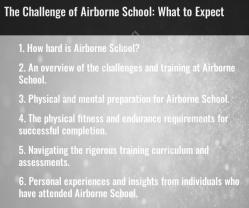What are the 4 types of army briefings?
In the U.S. Army, there are four main types of briefings that are commonly used for communication and information dissemination. Each type of briefing serves a specific purpose and format, and they are often employed in different situations to convey information effectively. The four types of Army briefings are:
Information Briefing:
- Purpose: An information briefing is used to provide factual information, updates, or reports to an audience. It aims to convey information accurately without seeking decisions or actions from the audience.
- Content: Information briefings focus on presenting data, facts, statistics, or updates on a specific topic. They are often used for sharing situational awareness, progress reports, or routine updates.
- Format: Information briefings are typically structured with an introduction, main points or content, and a conclusion. They are straightforward and objective in nature.
Decision Briefing:
- Purpose: A decision briefing is designed to present information to a decision-making authority or audience with the goal of seeking a decision, approval, or guidance on a specific issue or course of action.
- Content: Decision briefings include background information, options or alternatives, recommendations, and potential implications of the decision. They are used when a choice needs to be made, and the briefing is aimed at influencing that decision.
- Format: Decision briefings are often structured to guide the decision-making process. They provide decision-makers with the necessary information to make informed choices.
Mission Briefing:
- Purpose: A mission briefing is used to communicate the details of a specific mission, operation, or task to the individuals who will execute it. It ensures that all participants have a clear understanding of their roles and responsibilities.
- Content: Mission briefings include information on the mission's objectives, timeline, logistics, roles and responsibilities of team members, equipment, and safety considerations.
- Format: Mission briefings are highly structured and often include visual aids, maps, and diagrams to enhance understanding. Clarity and precision are essential to ensure mission success.
Staff Briefing:
- Purpose: A staff briefing is intended for members of a staff or team to coordinate and synchronize efforts, share information, and plan activities related to an operation or mission.
- Content: Staff briefings cover a wide range of topics, including updates on ongoing activities, coordination of resources, allocation of tasks, and discussions on strategies and plans.
- Format: Staff briefings are collaborative in nature and are conducted to facilitate discussions, coordinate actions, and ensure that all staff members are informed and aligned.
These four types of briefings are essential tools for effective communication and decision-making within the U.S. Army. Depending on the situation and the intended audience, the appropriate type of briefing is selected to achieve the desired objectives, whether it's providing information, making decisions, planning missions, or coordinating staff activities.
Briefing in the Ranks: Exploring the Four Types of Army Briefings
Army briefings are a vital part of military communication. They are used to inform, persuade, and motivate soldiers at all levels. There are four main types of Army briefings:
- Information briefings: Information briefings are used to provide soldiers with information about a particular topic. They can be used to introduce a new policy, explain a new procedure, or provide updates on a current mission.
- Decision briefings: Decision briefings are used to present a commander with different options for a course of action and to recommend a particular option. Decision briefings are typically given to commanders at higher levels, such as battalion commanders and brigade commanders.
- Mission briefings: Mission briefings are used to provide soldiers with the details of a mission, including the objective, the plan of attack, and the timeline. Mission briefings are typically given to soldiers at all levels, from squad leaders to platoon leaders.
- Staff briefings: Staff briefings are used to provide commanders with updates on the status of a mission or to discuss specific issues related to a mission. Staff briefings are typically given to commanders by their staff officers, such as the S-3 (operations officer) and the S-4 (logistics officer).
Effective Communication in the Military: The Different Types of Army Briefings
Army briefings must be effective in order to communicate important information to soldiers and to achieve the desired outcome. There are a few key elements that make for an effective Army briefing:
- Clarity: The briefing should be clear and concise. The briefer should use simple language and avoid jargon.
- Completeness: The briefing should be complete and provide all of the necessary information.
- Accuracy: The briefing should be accurate and up-to-date.
- Relevance: The briefing should be relevant to the audience. The briefer should tailor the briefing to the specific needs of the soldiers in the audience.
- Engagement: The briefing should be engaging and interesting. The briefer should use visuals and other aids to keep the audience's attention.
Mastering Military Briefings: A Comprehensive Overview of the Four Types
Each of the four types of Army briefings has its own specific purpose and format. Here is a more comprehensive overview of each type of briefing:
Information briefings: Information briefings are typically short and to the point. The briefer should focus on the most important information and avoid extraneous details. Visual aids can be used to help communicate the information more effectively.
Decision briefings: Decision briefings are typically more complex than information briefings. The briefer should present the commander with different options for a course of action and should recommend a particular option. The briefer should also be prepared to answer questions from the commander about the different options.
Mission briefings: Mission briefings are typically given to soldiers at all levels, from squad leaders to platoon leaders. The briefer should provide the soldiers with all of the details of the mission, including the objective, the plan of attack, and the timeline. The briefer should also be prepared to answer questions from the soldiers about the mission.
Staff briefings: Staff briefings are typically given to commanders by their staff officers. The briefer should provide the commander with updates on the status of a mission or should discuss specific issues related to a mission. The briefer should also be prepared to answer questions from the commander about the briefing.
By understanding the purpose and format of each type of Army briefing, soldiers can become more effective briefers and communicators.
